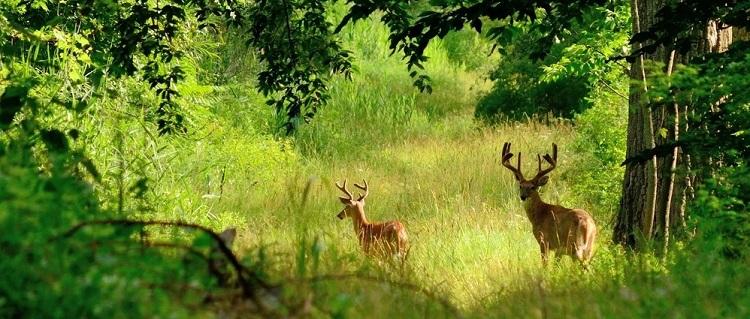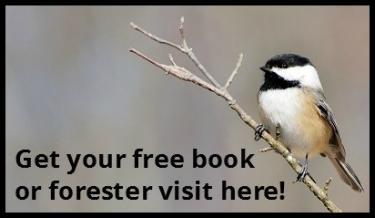Supporting Wildlife in Your Backyard
How To Best Provide Food, Water and Shelter
Do You Know?
Small Maine landowners are essential to wildlife conservation. Your actions can impact your community’s natural environment in many positive ways. On a small scale, you can set up a bird feeder. On a larger scale, you can improve living conditions for many types of wildlife by promoting the growth of certain types of trees. What do all living things need to survive? Food, water and shelter! Your woodlot provides these. When making changes to your property keep in mind trees and wet areas that benefit wildlife’s three primary needs of food, water, and shelter.
Wildlife Essentials
Food needs vary from one wildlife species to another. For example, some birds eat only certain types of seeds, while others eat
only insects. Artificially feeding wildlife can cause more harm than good since animals easily become dependent on these food sources. To best support wildlife in the long run, manage the plants in your woodlot to provide these various feeding opportunities. The mast, or fruit and nut, tree information below will assist you in planting foliage to aid wildlife nutrition.
Water availability is important, especially during the warm, summer months when areas become unusually dry. Make sure to provide access for wildlife to reach a natural or artificial water source. A water source, something as simple as a birdbath or a large bowl, can attract a variety of animals year round. Riparian areas or water features discussed below will aid you in establishing opportunities for nourishment.
Shelter is the place where animals can rest safely and care for their young, much in the same way people do. As a landowner you have the opportunity to create new protection and cover for different wildlife species on your property. Shelter may be anything from a den in a hillside for a red rox, to low-lying evergreen branches for a snowshoe hare, to fallen leaves on the forest floor for wood frogs. The snag, or dead tree, information below will help you establish a homey wildlife sanctuary.
Woodland Features That Provide Wildlife Essentials
Mast trees and shrubs are those that produce fruit, nuts, or seeds eaten by wildlife. Oak, beech, pin cherry, wild apple, shad brush, winter berry, hawthorn, and dogwood are examples of food species in Maine. Some wildlife, like wild turkeys, moose, and bears seek fruit and nuts for a large part of their diets. With proper management, like pruning and thinning out adjacent trees and shrubs, you can encourage food species to produce more food for wildlife on your property. Edges and borders of distinct natural areas are often a good place to concentrate your efforts.
Riparian areas (the wet edges of pools, marshes, and creeks) that form water features on your woodlot are home to plants and animals that cannot live elsewhere. These wet areas, typically 300 foot wide zones where woods meet streams and lakes, are important to more kinds of wildlife than any other habitat type in Maine. These features provide one of the main necessities for survival—water! They also provide shelter. Many breeding and nesting song birds, marsh birds, and ducks rely on riparian sections, while other wildlife use the cover provided by riparian areas to travel across otherwise open fields from one set of woods to another.
Snags, or dead standing trees, provide homes for 58 species of wildlife in Maine. Woodpeckers, chickadees, and other birds pick insects off the decaying bark and some birds and owls use the same snag as a nesting site year after year. Some wildlife have the skills to make their own nests in the cavities of trees while others depend on natural tree holes or previously occupied nests. Hawks also use snags for hunting viewpoints and moles burrow beneath their roots. As snags decay, they add nutrients to the soil and encourage new plants and trees to grow.
| Would you like a printer-friendly version of our Supporting Wildlife In Your Backyard Factsheet? |
| And take some time to complete Your Wildlife Checklist. Find out what next steps you can do to give the animals on your land all that they need. |



